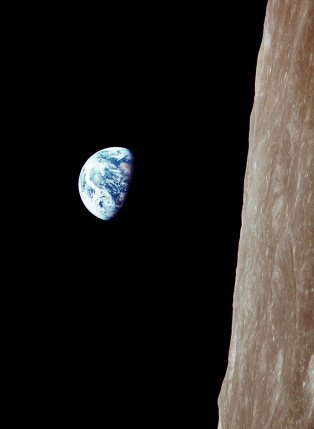File:Earthrise images - vertical orig - and horizontal.png
Earthrise_images_-_vertical_orig_-_and_horizontal.png (800 × 201 pixels, file size: 81 KB, MIME type: image/png)
<addthis />
Earthrise:
- Looking Out the Window of the Apollo Spacecraft
- Apollo 8, December 24, 1968
In order to take photographs of the far side of the moon the Apollo spacecraft had been rolled so that its windows pointed towards the lunar surface. During this time, the Moon was between the spacecraft and Earth, effectively cutting-off all radio communication with mission control. As Apollo 8 emerged from the far side on its fourth orbit, crew commander Frank Borman rolled the spacecraft so as to position its antennas for radio contact with mission control. Looking to the lunar horizon for reference he exclaimed - "Oh my God, look at that picture over there! Here's the Earth coming up!"
The famous photograph that was taken in the next two minutes is usually credited to crewman William Anders, although commander Frank Borman has always claimed that he took it.
It turns out that in fact three photographs were taken, one in black and white and two in colour. The black and white shot was taken first - by Borman, and the two colour shots were taken moments later by William Anders.
The curious thing about the images is the difference in the way the two men perceived what they were seeing. Frank Borman related the 'Earthrise' to a moonrise on Earth, with the lunar surface horizontal and the Earth rising above it.
William Anders framed his photographs from the perspective of being in orbit about the lunar equator. So his horizon was the plane in which he was travelling. This meant he framed it so the edge of the Moon was vertical, with planet Earth a little to the left but with its North and South poles aligned the same way as the North and South poles of the Moon.
(It is interesting to note that the colour photographs taken by William Anders are almost always re-published with the image on its side - ie from the perspective that Borman adopted for his B&W photograph).
But regardless of which way the photograph was taken, the image shows our entire world as a small and blue and very finite globe, with our nearest celestial neighbour a desolate presence in the foreground.
○
File history
Click on a date/time to view the file as it appeared at that time.
| Date/Time | Thumbnail | Dimensions | User | Comment | |
|---|---|---|---|---|---|
| current | 14:35, 22 February 2018 | 800 × 201 (81 KB) | Siterunner (talk | contribs) |
You cannot overwrite this file.
File usage
The following 2 pages use this file:

